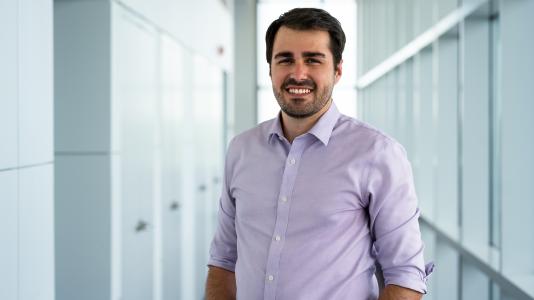
Gilberto Fabbris, a physicist with the Advanced Photon Source (APS), a U.S. Department of Energy (DOE) Office of Science user facility at DOE’s Argonne National Laboratory, is the recipient of the 2022 Alvin Van Valkenburg Award for his work in the area of condensed matter physics at high pressure.
This award is given every second year in the name of renowned physicist Alvin Van Valkenburg, co-inventor of the diamond anvil cell (DAC), to honor a young scientist who uses this device in his or her scientific research. Fabbris was presented with a medal and gave a talk on his work at the biannual 2022 Gordon Conference on Research at High Pressures, held in July at the Holderness School in New Hampshire.
A DAC is made of small diamonds, and allows scientists to put samples between those diamonds to exert massive amounts of pressure on them. This pressure forces changes in the samples, and scientists use the ultrabright X-rays of the APS to study those changes.
Fabbris’ work is particularly concerned with emergent electronic properties in strongly correlated electron systems. He has combined DACs in low-temperature and high-magnetic field environments with 4-probe electrical resistance as well as a broad range of synchrotron radiation spectroscopic and scattering techniques to interrogate novel electronic states at extreme pressures.
In a 2016 paper, Fabbris presented the first implementation of polarized X-ray absorption fine structure measurements in the DAC which, simultaneously with X-ray scattering, allowed him to establish a direct correlation between superconductivity and characteristics of the material.
In addition to his impactful research published as lead author, Fabbris currently leads the high-pressure research program at beamline 4-ID-D of the APS. In that role, he intimately collaborates with a broad array of users who rely on his expertise with high-pressure techniques to advance leading questions in correlated electron physics. A recent example is his collaboration with a Los Alamos group to shed light into the nature of superconductivity in a particular material.
“I’m very honored to receive this award,” Fabbris said. “It has only been possible due to the support of the APS community, so more than an individual recognition it’s a testament to the strength of APS to foster cutting-edge science.”
Fabbris earned his Bachelor of Science and Master of Science degrees in physics at the Universidade Estadual de Campinas and the Brazilian Synchrotron Light Laboratory, and his Ph.D. in physics at Argonne National Laboratory and Washington University in St. Louis. He is a member of the X-ray Science Division Magnetic Materials Group at the APS.
About the Advanced Photon Source
The U. S. Department of Energy Office of Science’s Advanced Photon Source (APS) at Argonne National Laboratory is one of the world’s most productive X-ray light source facilities. The APS provides high-brightness X-ray beams to a diverse community of researchers in materials science, chemistry, condensed matter physics, the life and environmental sciences, and applied research. These X-rays are ideally suited for explorations of materials and biological structures; elemental distribution; chemical, magnetic, electronic states; and a wide range of technologically important engineering systems from batteries to fuel injector sprays, all of which are the foundations of our nation’s economic, technological, and physical well-being. Each year, more than 5,000 researchers use the APS to produce over 2,000 publications detailing impactful discoveries, and solve more vital biological protein structures than users of any other X-ray light source research facility. APS scientists and engineers innovate technology that is at the heart of advancing accelerator and light-source operations. This includes the insertion devices that produce extreme-brightness X-rays prized by researchers, lenses that focus the X-rays down to a few nanometers, instrumentation that maximizes the way the X-rays interact with samples being studied, and software that gathers and manages the massive quantity of data resulting from discovery research at the APS.
This research used resources of the Advanced Photon Source, a U.S. DOE Office of Science User Facility operated for the DOE Office of Science by Argonne National Laboratory under Contract No. DE-AC02-06CH11357.
Argonne National Laboratory seeks solutions to pressing national problems in science and technology. The nation’s first national laboratory, Argonne conducts leading-edge basic and applied scientific research in virtually every scientific discipline. Argonne researchers work closely with researchers from hundreds of companies, universities, and federal, state and municipal agencies to help them solve their specific problems, advance America’s scientific leadership and prepare the nation for a better future. With employees from more than 60 nations, Argonne is managed by UChicago Argonne, LLC for the U.S. Department of Energy’s Office of Science.
The U.S. Department of Energy’s Office of Science is the single largest supporter of basic research in the physical sciences in the United States and is working to address some of the most pressing challenges of our time. For more information, visit https://energy.gov/science.